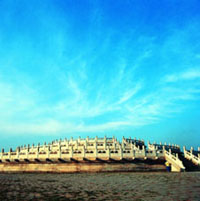 To worship nature, the gods, and their ancestors, ancient Chinese people built countless sacrificial establishments throughout both rural and urban areas. Nowadays, these establishments, built in various styles, have become part of the unique cityscapes of Beijing.
To worship nature, the gods, and their ancestors, ancient Chinese people built countless sacrificial establishments throughout both rural and urban areas. Nowadays, these establishments, built in various styles, have become part of the unique cityscapes of Beijing.
Several kilometers southeast of the Imperial Palace, there is a large architectural complex named the Temple of Heaven. In ancient times, the emperor would come here the first month of every summer to worship heaven and to pray for a good harvest. Because of its compact layout, unique structure, and splendid decorations, the temple is regarded as the most exquisite and beautiful existing complex of ancient buildings in China. It also enjoys a high reputation around the world. At Walt Disney World in Orlando, Florida, USA, there is a replica of the temple's Hall of Prayer for Good Harvests that represents the theme park's Chinese Hall.
The Temple of Heaven was built in 1420, the 18th year of Emperor Yong Le's reign during the Ming Dynasty (1368-1644). It covers an area of 2.7 square kilometers and is four times the size of the Imperial Palace. Because Chinese emperors considered themselves the Sons of Heaven, they had to cede supremacy to the God of Heaven in terms of abode.
The layout of the temple is based on the concept of "heaven" in ancient Chinese culture. At its southern extreme is a square wall representing the earth, and at its northern extreme is a semi-circular wall representing heaven. The design is based on the primitive belief that heaven was round, and the earth was square. Because the way to heaven from earth was believed to be extremely long, a 300-meter-long paved walkway named Haiman Road (Road Submerged by the Sea) was built. Ancient Chinese people believed that this road towards the halls of worship was symbolic of the road to heaven. The walkway is above ground level; and as you stand on it and look around, you feel as if you are much closer to heaven.
One of the temple's main buildings, the Hall of Prayer for Good Harvests, possesses a beauty that arouses admiration, as well as an exquisite architectural design. "Skyscrapers are much higher than the Hall of Prayer for Good Harvests," a French architect once said after visiting the hall. "But they aren't as magnificent and meaningful as the hall; and they are less than it in artistic touch."
The hall is supported by mutually connected wooden beams and brackets and 28 wooden columns that symbolize 28 constellations. The four columns in the center, called the "dragon-well columns," represent the four seasons. Each is 19.2 meters tall and wide enough for two and a half persons, with connected arms, to wrap themselves around it. The four columns are surrounded by two concentric rings of 12 columns each. The inner ring symbolizes the 12 months of the year, and the outer, the 12 divisions of day and night according to the old Chinese way of reckoning time. In 1889, during the Qing Dynasty (1644-1911) and the 15th year of Emperor Guan Xu's reign, the hall was struck by lightning and caught fire. At that time, the columns were made of eaglewood. People could smell the fragrance emitted by the burning columns from kilometers away.
Another marvelous structure in the temple is the Echo Wall, a circular wall of polished bricks that surrounds the temple's Imperial Vault of Heaven. If a person stands at one end and murmurs against the wall, another person can hear his or her voice at the other end. Many visitors like to try this personally when they visit the temple.
Besides the God of Heaven, Chinese emperors worshiped many other gods, including the gods of the earth, water, farming, war, society, religion, and the citizen. They also practiced ancestral worship. Sacrificial temples of various kinds are scattered around Beijing. Among the best known are the Temple of Heaven in the south, the Temple of the Earth in the north, the Temple of the Sun in the east, and the Temple of the Moon in the west. In addition, today's Laboring People's Cultural Palace, located in the east of the Tian'anmen Rostrum, served as the imperial temple for ancestral worship during the Ming and Qing dynasties; and the Altar of Land and Grain, situated in the west of the Tian'anmen Rostrum, was a venue for offering sacrifices to the gods of land and grain.
As time goes on, these imperial sacrificial establishments have become places for leisure and amusement. The peace and good harvests that feudal emperors once prayed for now exist, and are reflected in the elderly doing morning exercises, the young people reading, the toddlers learning how to speak, and the tourists enjoying beautiful scenery on the temples' grounds. These sacrificial temples have thus become more vigorous today.
(China Pictorial December 10, 2002)
|

